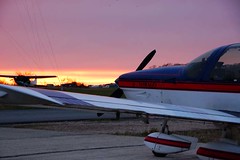Keep the Runway Lights On
The weather played along: I was able to fly every evening last week. A minor hitch came up with the the plane being an N-reg (registered in the US). We sorted it out by using this darling TB10, a friendly, light plane that seemed eager to please; not something I’d ever say about the Saratoga!
The navigation was a lot less exciting than I’d hoped, looking out at lights with a map on my lap:
“What’s that up there?”
“Er, Oxford? No, no, give me a second. Banbury?”
“Yep, what’s that road up there then?”
“Um, M4?”
“Correct again. Follow it.”
“OK.” I lined the plane up with the pretty twinkly red lights of stationary traffic and hoped that Alistair wouldn’t make me turn off onto a roundabout.
Of course, there is more to it than that. Distances are a completely different perspective: we could see Birmingham from 2400 feet above Oxford, something that would never happen during the day. Line features look very different. Roads are good. Rivers and railway lines? Not so much. Watch for black-outs: if you can’t see lights, there’s a good chance you are about to fly into cloud … or, worse, a mountain. As for an engine failure? Pray.
The airfield stayed open until 8 and twice we were the last ones there, the runway lights turning off behind us as we landed. It felt so final.
We finished just before the weather began to turn; snow was forecast for the following evening.
So now I have my night rating and I can fly on instruments … but only if it’s dark.









As my instructor said to me when discussing the theory of forced landings at night.
Find the black spot you want to use as your resting place, line up, turn the landing lights on, and if you don’t like what you see, turn them off again … at 400 ft it’s probably too late to choose an alternate spot :)
LOL now that’s something I don’t even want to think about!